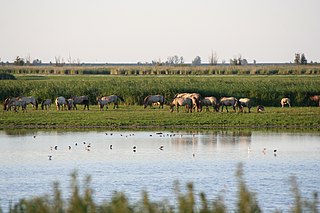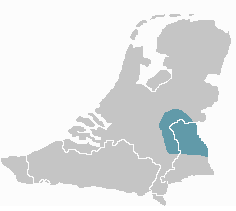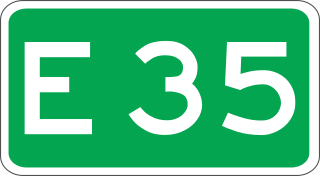
Low Saxon, also known as West Low German are a group of Low German dialects spoken in parts of the Netherlands, northwestern Germany and southern Denmark. It is one of two dialect groups, the other being East Low German.

Gelderland, also known as Guelders in English, is a province of the Netherlands, occupying the centre-east of the country. With a total area of 5,136 km2 (1,983 sq mi) of which 176 km2 (68 sq mi) is water, it is the largest province of the Netherlands by land area, and second by total area. Gelderland shares borders with six other provinces and the German state of North Rhine-Westphalia.

Apeldoorn is a municipality and city in the province of Gelderland in the centre of the Netherlands. The municipality of Apeldoorn, including the of villages of Beekbergen, Loenen, Ugchelen and Hoenderloo, had a population of 165,525 on 1 December 2021. The western half of the municipality lies on the Veluwe ridge, with the eastern half in the IJssel valley.

Nunspeet is a municipality and town in the central Netherlands. It has been an agricultural site since prehistoric times. The municipality contains a number of villages, namely Hulshorst, Elspeet, and Vierhouten. Nunspeet has a vivid historical foundation, called Nuwenspete. In 1972 Nunspeet became a separate municipality after having been part of Ermelo before.

In historical and comparative linguistics, Low Franconian is a linguistic category used to classify a number of historical and contemporary West Germanic varieties closely related to, and including, the Dutch language. Most dialects and languages included within this category are spoken in the Netherlands, northern Belgium (Flanders), in the Nord department of France, in western Germany, as well as in Suriname, South Africa and Namibia.

The Oostvaardersplassen is a nature reserve in the Netherlands, managed by the Staatsbosbeheer. Covering about 56 square kilometres (22 sq mi) in the province of Flevoland, it is an experiment in rewilding. It is in a polder created in 1968; by 1989, its ecological interest had resulted in its being declared a Ramsar wetland. It became part of Nieuw Land National Park when that was established in 2018.

Dieren is a town in the eastern Netherlands. It is located in Rheden, Gelderland, between Zutphen and Arnhem, on the bank of the IJssel.

Oosterbeek is a village in the eastern part of Netherlands. It is located in the municipality of Renkum in the province of Gelderland, about 5 km (3.1 mi) west of Arnhem.

West-Veluws is a Low Franconian dialect of the Dutch province of Gelderland. It is spoken in several Veluwe municipalities and villages including: Nunspeet, Putten, Ermelo (Armelo), Harderwijk (Harderwiek), Uddel, Nijkerk (Niekark), Appel, Scherpenzeel (Schaarpezeel), the municipality of Barneveld (Barreveld) and some villages of the municipality of Ede.

De Hoge Veluwe National Park is a Dutch national park in the province of Gelderland near the cities of Ede, Wageningen, Arnhem and Apeldoorn. It is approximately 55 km2 in area, consisting of heathlands, sand dunes, and woodlands. It is situated in the Veluwe, the area of the largest terminal moraine in the Netherlands. Most of the landscape of the park and the Veluwe was created during the last ice age. The alternating sand dune areas and heathlands may have been caused by human utilization of the surrounding lands. The park forms one of the largest continuous nature reserves in the Netherlands.

Emst is a village in the municipality of Epe in the province of Gelderland in the Netherlands. It is the birthplace of former footballer Marc Overmars. Emst is located in the forest area of Veluwe.

Vaassen is one of four villages in the Dutch municipality of Epe. Vaassen is situated between Apeldoorn and Zwolle, on the eastern edge of the Veluwe in the province of Gelderland. Vaassen was an independent municipality up to 1 January 1818, when it merged with Epe.

Kleverlandish is a group of Low Franconian dialects spoken on both sides of the Dutch-German border along the Meuse and Rhine rivers.

Zuid-Kennemerland National Park is a conservation area on the west coast of the province of North Holland. It was established in 1995.

Arnhem Centraal railway station is the largest railway station in the city of Arnhem in Gelderland, Netherlands. It was opened on 14 May 1845 and is located on the Amsterdam–Arnhem railway, the Arnhem–Leeuwarden railway and the Arnhem–Nijmegen railway. The station opened at the same time as the Amsterdam–Arnhem railway, that continues into Germany via the Oberhausen–Arnhem railway.

Oost-Veluws is a Low Saxon dialect of the Dutch province of Gelderland. The dialect is endangered as there are few native speakers left.

Veluwezoom National Park is a national park in the Netherlands located in the province of Gelderland. It is the oldest national park in the Netherlands. It has a surface area of about 50 square kilometers at the southeastern edge of the Veluwe, a complex of terminal push moraines from the Saalian glaciation. The park has a pronounced relief by Dutch standards, with its highest point at 110 metres (360 ft) above sea level. It is a private national park, owned by Vereniging Natuurmonumenten, the largest nature conservation organisation in the Netherlands.
This article discusses transport in Apeldoorn, the Netherlands. Apeldoorn is a city located 60 miles southeast of Amsterdam. The municipality has a population of about 156,000, with 138,000 living in the town itself.

European route E 35 (E 35) is a north–south European route, running from Amsterdam in the Netherlands to Rome in Italy. In the Netherlands, the highway runs from its northern terminus in Amsterdam eastwards through Utrecht and Arnhem to the German border, near Zevenaar. The road runs concurrently with three other motorways over its entire length, starting on Rijksweg 10 (A10) around Amsterdam, then A2 from southern Amsterdam up to Utrecht, and the last part on A12 until it reaches the German border in the east.
The evacuation of Arnhem was the departure, forcibly conducted by the German Wehrmacht, of tens of thousands of inhabitants of the Dutch city of Arnhem and nearby places from 23 to 25 September 1944 during the Battle of Arnhem in World War II. The occupying German forces decided to evacuate almost the entire civilian population in order to better defend the city against the Allied Operation Market Garden. After the city was evacuated, many houses and other buildings were looted by various groups of organised and unorganised German soldiers and pro-German collaborators.
























